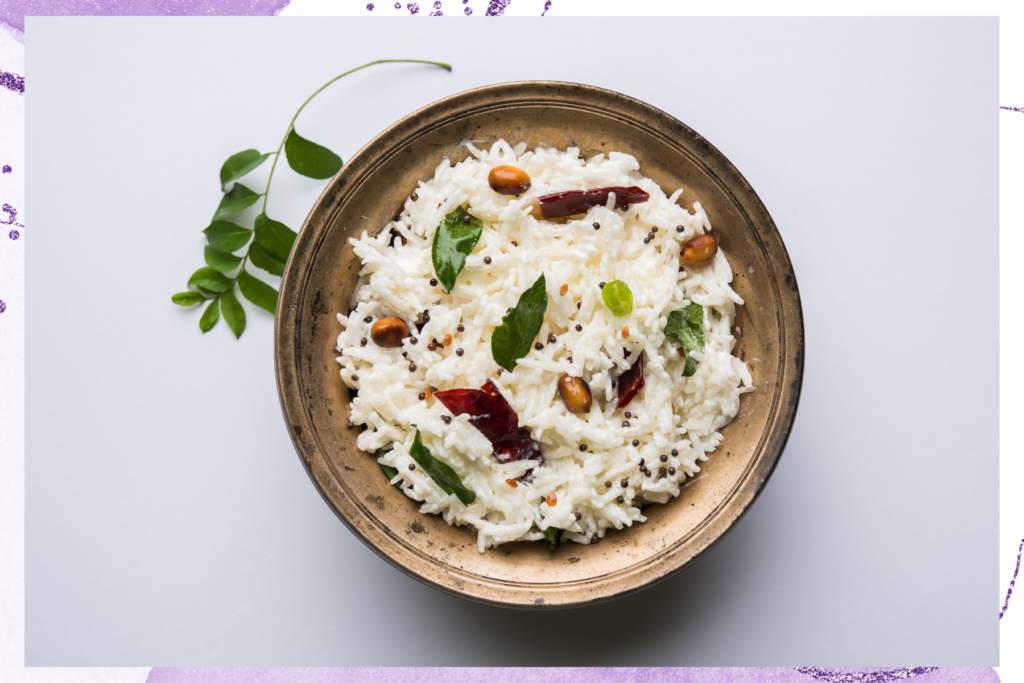
There’s nothing quite so compelling as the ultimate comfort food. Whether it’s mac and cheese, roast chicken, mashed potatoes or anything else in our great American Rolodex of cozy dishes, it is an unfailingly magical experience to make and enjoy a dish that can take you back home, or just back to your bed, in the span of an instant.
From smell to taste to post-meal nap, everyone has at least one of those MVP culinary offerings in their arsenal. For my family, and many others in the South Indian diaspora, this is thayir saadham.
Thayir saadham is the Tamil moniker for curd (plain yogurt) rice. It’s also known as daddojanam, mosaranna, dahi chawal, even bangla bath in other languages, but it’s essentially a mixed rice “risotto” of sorts that is simultaneously understated and passionately loved. It’s got an almost cult-level following and unique fandom for being that zero-fuss, no-fail, back-of-the-pantry dish you can make any time. Perhaps the convenience factor plays into its appeal; you can make thayir saadham in its simplest form with just a bit of cooked rice from the night before and a few spoons (or a lot of spoons) of plain yogurt.
View this post on Instagram
In my house, thayir saadham has been an unimpeachable staple that’s almost grown up with me. Earliest memories feature a hyper-mixed (pesanji-fied, for those in the know) mush fed to me as a toddler and a fond association with my mom. My mom and I would always pick out a tub of Dannon Yogurt on grocery runs together, the faded tubs of which now hold loose change, holy ash and other wares that are decidedly non-yogurt and endearingly characteristic of many desi households. And from toddlerhood to adulthood, to this day my mom always follows a non-Indian restaurant meal, no matter how good it was, with “it was ok, but I’ll just have some thayir saadham at home.”
[Read Related: A Cup Of Chai Shai With Entrepreneur Rabia Faisal]
As I grew, the possibilities of thayir saadham expanded alongside my worldview. The curd rice offered at the temple featured tempered lentils and mustard seed, sometimes green chili and curry leaves. At gatherings, the aunties I grew up around all seemed to have their own version. Bitter arguments about whether or not grapes or pomegranate seeds belonged in each home-brew were my version of the pineapple-on-pizza debate. I’ve seen raisins and fruits, warm and cold, hot and mild and everything in-between in thayir saadham, and everyone takes their recipe both seriously and personally as their piece of home.
That being said, the version without the fancy add-ins was the version I really grew up on. At its core, it was nothing but rice and yogurt, which over time shifted from Dannon to either a European-style yogurt or Gopi, the brand my mom picks up from the Indian grocery stores that have become infinitely more accessible in the last decade-plus.
View this post on Instagram
By the time I left home for college, my bowl couldn’t be complete without my favorite brand of urugai, or pickle. This is not the stuff in the canned section at Safeway, but South Asian-style mangoes, citrus, garlic, or onion preserved with red chili, fenugreek and mustard seeds, fresh from the Indian store nearby or, better, fresh out of someone’s luggage from their latest trip to India. Put all together, thayir saadham with some urugai is the dish I always associate with home.
Since striking out on my own, the impact of the humble bowl of yogurt rice is evident. In my fridge, there’s always a tub of plain yogurt or even sour cream for the “safe” meal, hidden behind the global clash of ingredients I use to recreate Instagram recipes that make up most of my new diet. I’ve got a few jars of urugai similarly stashed away, always on standby should their service be needed.
On days I can’t bring myself to cook, I can always count on some Instant Pot rice and yogurt to lift my mood. The effect is so immediate that when my mom forwarded a doctored Whatsapp graphic erroneously claiming that the word thayir somehow influenced the etymology of tryptophan, an amino acid that’s often used to treat anxiety, I almost believed it. Thayir saadham is powerful stuff.
[Read Related: An Ode to the Classic Dahi Baigan Dip]
Today, my identity and upbringing no longer dominate nearly every aspect of my life. I’m navigating the newness of being a Tamil-American, emphasis on the American, in a world where so many other cultures and people dominate my surroundings. Being surrounded by so many types of people has been beautiful and enlightening for me, but it’s also created in my relative isolation a strong feeling of homesickness at times, a longing to be around people that speak the Tamil I’m used to hearing at home or eat the foods I’m most comfortable with. But in meeting or talking to others on occasion, whether they’ve just immigrated here from South India or, like me, grew up here with one foot in each cultural pool, I find a sense of comfort in that we all seem to have a tub of plain yogurt in the back of our fridges waiting to take us home.
Feature image courtesy of Stockimagefactory.com via Shutterstock




